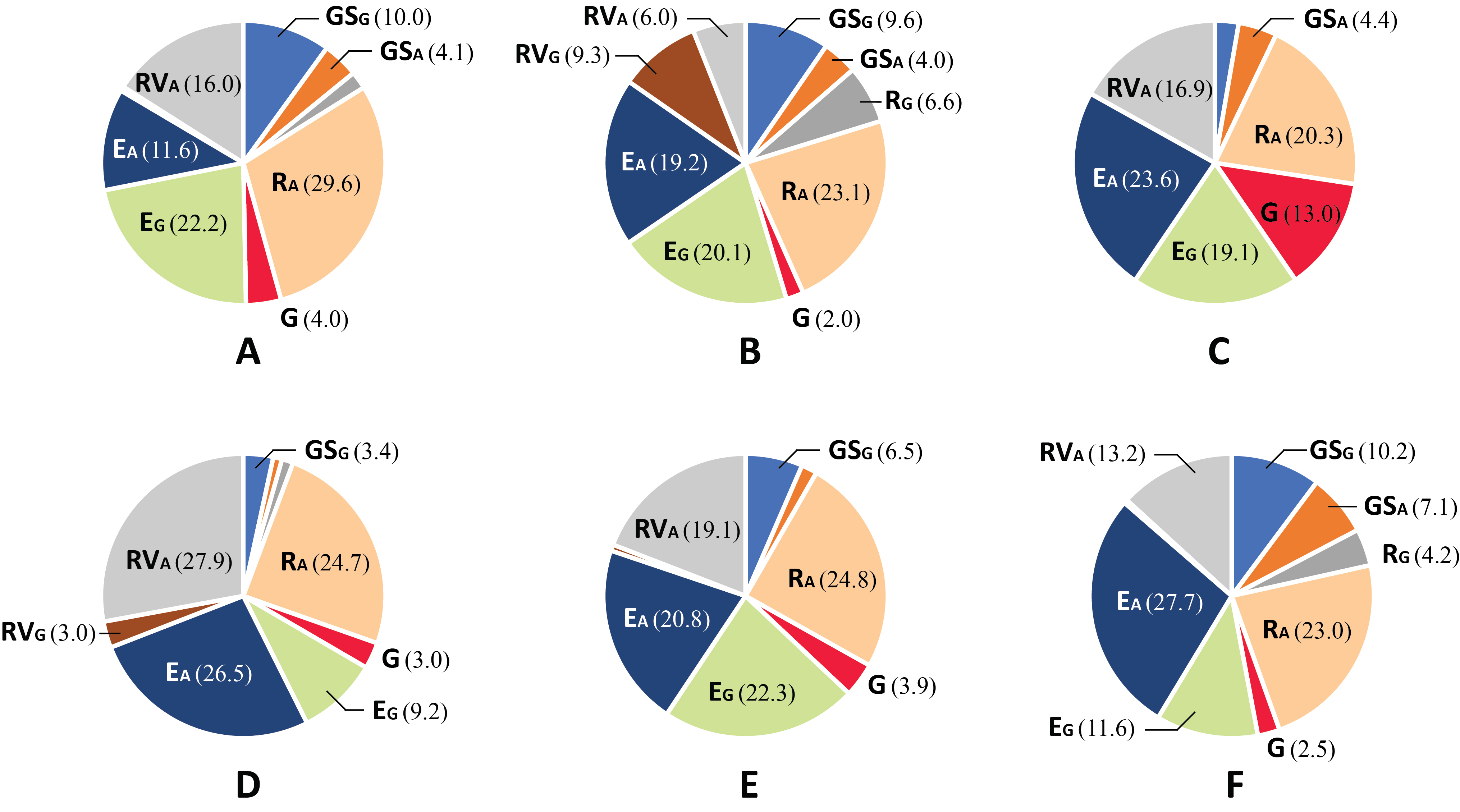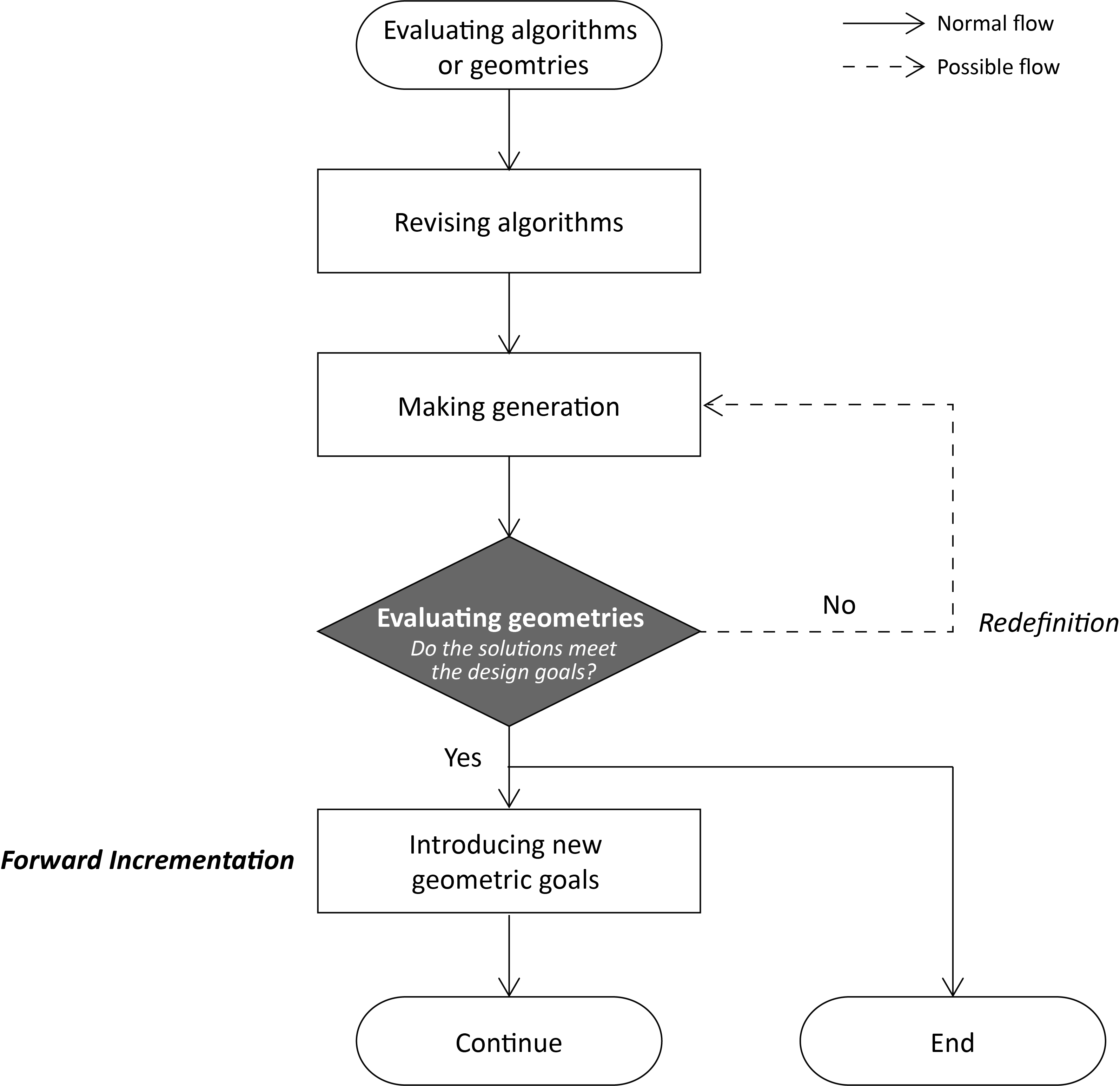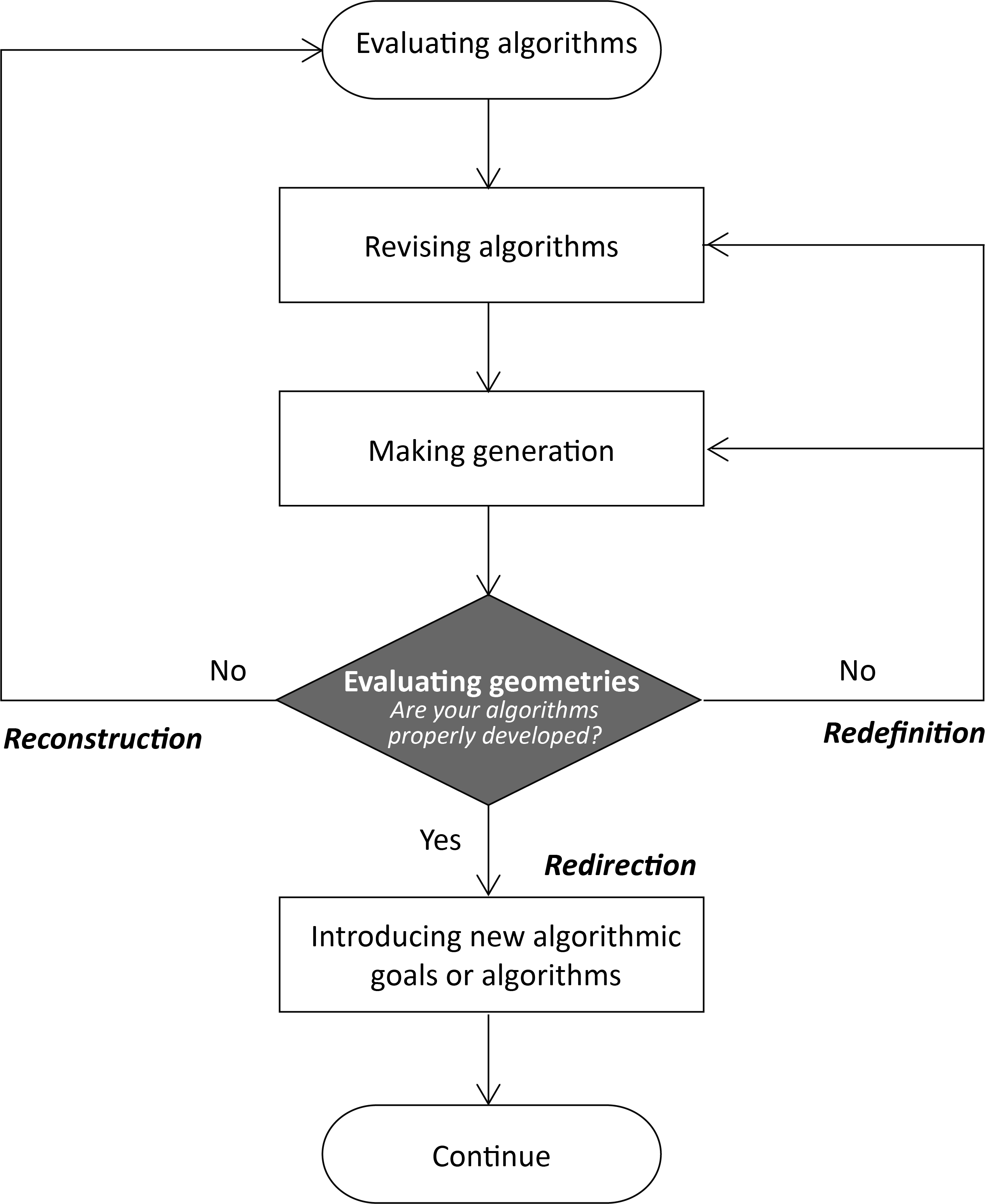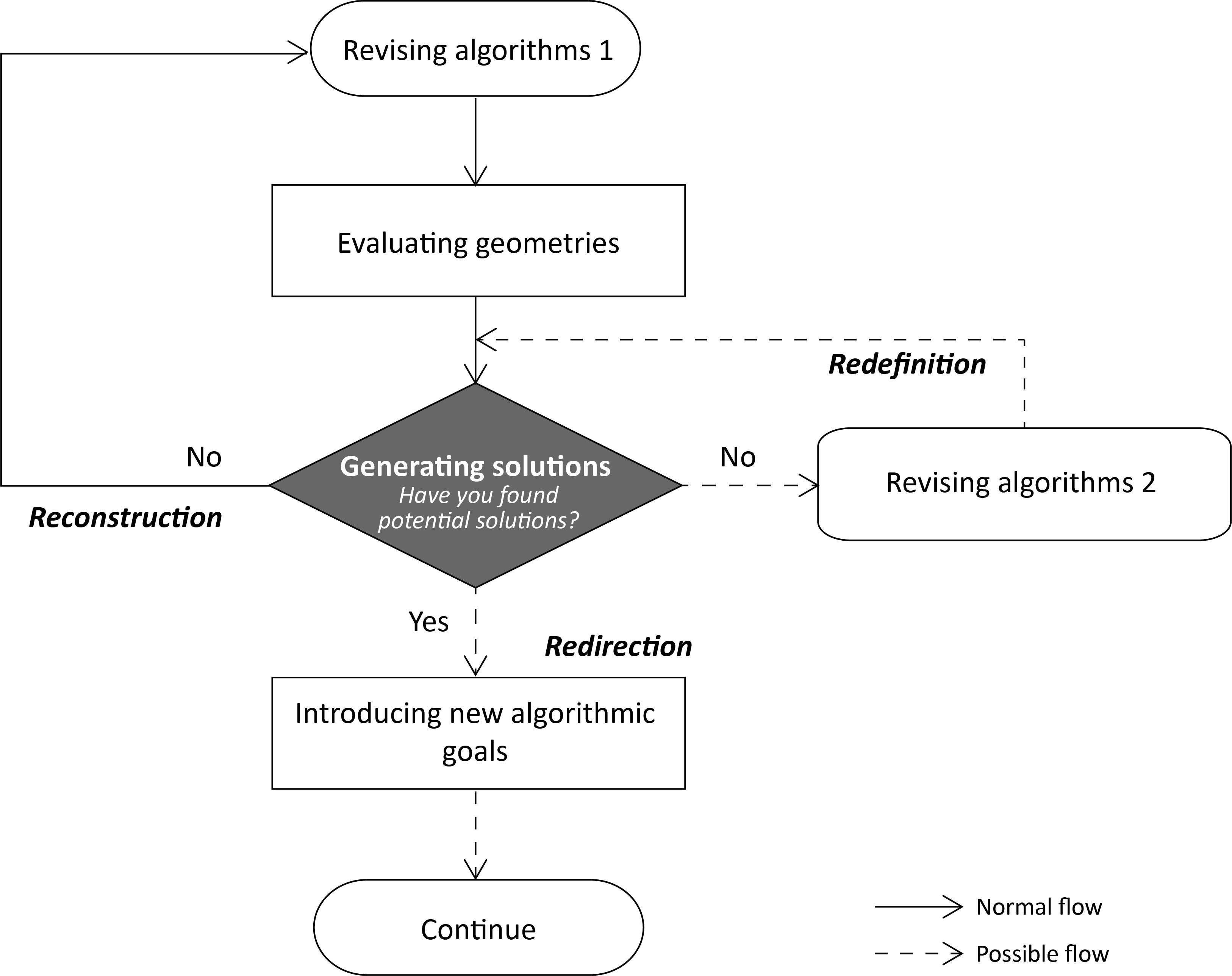Creative Decision-Making Processes in Parametric Design
Abstract
1. Introduction
2. Parametric Design Processes
3. Decision-Making and Creativity
4. Protocol Study
4.1. Research Procedure
4.2. Coding Results
4.3. Decision-Making Patterns
5. Creative DMPs in Parametric Design
5.1. Conclusive DMP
5.2. Confirmative DMP
5.3. Simulative DMP
6. Discussion
6.1. Creative DMPs in Sketching, Computer-Aided Design, and Parametric Design
6.2. Creative DMPs in Teamwork and Macro-Cognitive Approaches
7. Conclusions
Author Contributions
Funding
Conflicts of Interest
References
- Jones, J.C. A Method of Systematic Design. In Conference on Design Methods; Jones, J.C., Thornley, D.G., Eds.; Pergamon Press: Oxford, UK, 1963; pp. 53–73. [Google Scholar]
- Stempfle, J.; Badke-Schaub, P. Thinking in design teams—An analysis of team communication. Des. Stud. 2002, 23, 473–496. [Google Scholar] [CrossRef]
- Oxman, R. Digital architecture as a challenge for design pedagogy: Theory, knowledge, models and medium. Des. Stud. 2008, 29, 99–120. [Google Scholar] [CrossRef]
- Ochoa, C.E.; Capeluto, I.G. Strategic decision-making for intelligent buildings: Comparative impact of passive design strategies and active features in a hot climate. Build. Environ. 2008, 43, 1829–1839. [Google Scholar] [CrossRef]
- Chan, F.T.S.; Jiang, B.; Tang, N.K.H. The development of intelligent decision support tools to aid the design of flexible manufacturing systems. Int. J. Prod. Econ. 2000, 65, 73–84. [Google Scholar] [CrossRef]
- Hopfe, C.J.; Augenbroe, G.L.M.; Hensen, J.L.M. Multi-criteria decision making under uncertainty in building performance assessment. Build. Environ. 2013, 69, 81–90. [Google Scholar] [CrossRef]
- Holzer, D.; Hough, R.; Burry, M. Parametric Design and Structural Optimisation for Early Design Exploration. Int. J. Archit. Comput. 2007, 5, 625–643. [Google Scholar] [CrossRef]
- Lee, J.H.; Gu, N.; Ostwald, M.J. Creativity and parametric design? Comparing designer’s cognitive approaches with assessed levels of creativity. Int. J. Des. Creat. Innov. 2015, 3, 78–94. [Google Scholar] [CrossRef]
- Yu, R.; Gu, N.; Lee, J.H. Comparing designers’ behavior in responding to unexpected discoveries in parametric design environments and geometry modeling environments. Int. J. Archit. Comput. 2013, 11, 393–414. [Google Scholar] [CrossRef]
- Woodbury, R. Elements of Parametric Design; Routledge: London, UK; New York, NY, USA, 2010. [Google Scholar]
- Blosiu, J.O. Use of Synectics as An Idea Seeding Technique to Enhance Design Creativity. In Proceedings of the Systems, Man, and Cybernetics IEEE SMC 99 Conference Proceedings, Tokyo, Japan, 12–15 October 1999; Volume 1003, pp. 1001–1006. [Google Scholar]
- Iordanova, I. Teaching Digital Design Exploration: Form Follows. Int. J. Archit. Comput. 2007, 5, 685–702. [Google Scholar] [CrossRef]
- Iordanova, I.; Tidafi, T.; Guité, M.; Paoli, G.D.; Lachapelle, J. Parametric methods of exploration and creativity during architectural design: A Case study in the design studio. In Proceedings of the 13th International Conference, Montreal, QC, Canada, 17–19 June 2009; pp. 423–439. [Google Scholar]
- Barrios Hernandez, C.R. Thinking parametric design: Introducing parametric Gaudi. Des. Stud. 2006, 27, 309–324. [Google Scholar] [CrossRef]
- Jones, J.C. Design Methods; John Wiley & Sons Inc.: New York, NY, USA, 1992. [Google Scholar]
- Cardenas, C.A. Modeling Strategies: Parametric Design for Fabrication in Architectural Practice; Harvard University: Cambridge, NJ, USA, 2008. [Google Scholar]
- Kolarevic, B. (Ed.) Architecture in the Digital Age: Design and Manufacturing; Spon Press-Taylor & Francis Group: New York, NY, USA; London, UK, 2003. [Google Scholar]
- Hanna, S.; Turner, A. Teaching Parametric Design in Code and Construction. In Proceedings of the SiGraDi2006/Educacion y Desarrollo Academico, Santiago, Chile, 21–23 November 2006; pp. 158–161. [Google Scholar]
- Sutherland, I.E. Sketch pad: A man-machine graphical communication system. In Proceedings of the AFIPS Spring Joint Computer Conference, Detroit, MI, USA, 21–23 May 1963; pp. 329–346. [Google Scholar]
- Lee, J.Y.; Kim, K. Geometric reasoning for knowledge-based parametric design using graph representation. Comput. Aided Des. 1996, 28, 831–841. [Google Scholar] [CrossRef]
- Salim, F.; Burry, J. Software Openness: Evaluating Parameters of Parametric Modeling Tools to Support Creativity and Multidisciplinary Design Integration. In Computational Science and Its Applications—ICCSA 2010; Taniar, D., Gervasi, O., Murgante, B., Pardede, E., Apduhan, B., Eds.; Springer: Berlin/Heidelberg, Germany, 2010; Volume 6018, pp. 483–497. [Google Scholar]
- Burry, M. Scripting Cultures: Architectural Design and Programming; Wiley: Hoboken, NJ, USA, 2011. [Google Scholar]
- Gero, J.S.; Neill, T.M. An approach to the analysis of design protocols. Des. Stud. 1998, 19, 21–61. [Google Scholar] [CrossRef]
- Gero, J.S. Design Prototypes: A Knowledge Representation Schema for Design. Ai Mag. 1990, 11. [Google Scholar] [CrossRef]
- Lee, J.H.; Gu, N.; Ostwald, M.J.; Jupp, J. Understanding Cognitive Activities in Parametric Design. In Global Design and Local Materialization; Zhang, J., Sun, C., Eds.; Springer: Berlin/Heidelberg, Germany, 2013; pp. 38–49. [Google Scholar]
- Lee, J.H.; Gu, N.; Williams, A. Parametric design strategies for the generation of creative designs. Int. J. Archit. Comput. 2014, 12, 263–282. [Google Scholar] [CrossRef]
- Lee, J.H.; Ostwald, M.J.; Gu, N. Design Thinking: Creativity, Collaboration and Culture; Springer International Publishing: Cham, Switzerland, 2020. [Google Scholar] [CrossRef]
- Wang, Y.; Ruhe, G. The Cognitive Process of Decision Making. Int. J. Cogn. Inform. Nat. Intell. 2007, 1, 73–85. [Google Scholar] [CrossRef]
- Von Neumann, J.; Morgenstern, O. Theory of Games and Economic Behavior; Princeton University Press: Princeton, NJ, USA, 1947. [Google Scholar]
- Frederick, S. Cognitive Reflection and Decision Making. J. Econ. Perspect. 2005, 19, 25–42. [Google Scholar] [CrossRef]
- Crozier, R.; Ranyard, R. Cognitive process models and explanations of decision making. In Decision Making: Cognitive Models and Explanations; Crozier, R., Ranyard, R., Svenson, O., Eds.; Routledge: London, UK; New York, NY, USA, 2002; pp. 5–20. [Google Scholar]
- Harte, J.M.; Koele, P. Psychometric and methodological aspects of process tracing research. In Decision Making: Cognitive Models and Explanations; Crozier, R., Ranyard, R., Svenson, O., Eds.; Routledge: London, UK; New York, NY, USA, 2002; pp. 21–34. [Google Scholar]
- Stirling, W.C. Satisficing Games and Decision Making: With Applications to Engineering and Computer Science; Cambridge University Press: Cambridge, UK, 2003. [Google Scholar]
- Janis, I.L.; Mann, L. Decision Making: A Psychological Analysis of Conflict, Choice, and Commitment; Free Press: New York, NY, USA, 1977. [Google Scholar]
- Isen, A.M. Positive affect and decision making. In Handbook of Emotions; The Guilford Press: New York, NY, USA, 1993; pp. 261–277. [Google Scholar]
- Plous, S. The Psychology of Judgment and Decision Making; McGraw-Hill Education: New York, NY, USA, 1993. [Google Scholar]
- Bazerman, M.H.; Moore, D.A. Judgment in Managerial Decision Making; John Wiley & Sons: Hoboken, NJ, USA, 2009. [Google Scholar]
- Huber, G.P. A Theory of the Effects of Advanced Information Technologies on Organizational Design, Intelligence, and Decision Making. Acad. Manag. Rev. 1990, 15, 47–71. [Google Scholar] [CrossRef]
- Eisenhardt, K.M.; Zbaracki, M.J. Strategic Decision Making. Strateg. Manag. J. 1992, 13, 17–37. [Google Scholar] [CrossRef]
- Klein, G.A.; Orasanu, J.; Calderwood, R.; Zsambok, C.E. Decision Making in Action: Models and Methods; Ablex Publishing: Norwood, NJ, USA, 1993. [Google Scholar]
- Bellman, R.E.; Zadeh, L.A. Decision-Making in a Fuzzy Environment. Manag. Sci. 1970, 17. [Google Scholar] [CrossRef]
- Jarrahi, M.H. Artificial intelligence and the future of work: Human-AI symbiosis in organizational decision making. Bus. Horiz. 2018, 61, 577–586. [Google Scholar] [CrossRef]
- Duan, Y.; Edwards, J.S.; Dwivedi, Y.K. Artificial intelligence for decision making in the era of Big Data—Evolution, challenges and research agenda. Int. J. Inf. Manag. 2019, 48, 63–71. [Google Scholar] [CrossRef]
- Vliegen, H.J.W.; Mal, H.H.V. Rational decision making: Structuring of design meetings. IEEE Trans. Eng. Manag. 1990, 37, 185–190. [Google Scholar] [CrossRef][Green Version]
- Nikander, J.B.; Liikkanen, L.A.; Laakso, M. The preference effect in design concept evaluation. Des. Stud. 2014, 35, 473–499. [Google Scholar] [CrossRef]
- Ullman, D.G. Robust decision-making for engineering design. J. Eng. Des. 2001, 12, 3–13. [Google Scholar] [CrossRef]
- Wallas, G. The Art of Thought; Harcourt Brace: New York, NY, USA, 1926. [Google Scholar]
- Guilford, J.P. The Nature of Human Intelligence; McGraw-Hill: New York, NY, USA, 1967. [Google Scholar]
- Hayes, J.R. Cognitive processes in Creativity. In Handbook of Creativity. Perspectives on Individual Differences; Glover, J.A., Ronning, R.R., Reynolds, C.R., Eds.; Plenum Press: New York, NY, USA, 1989; pp. 135–145. [Google Scholar]
- Sternberg, R.J. The development of creativity as a decision-making process. In Creativity and Development; Sawyer, R.K., John-Steiner, V., Moran, S., Sternberg, R.J., Feldman, D.H., Nakamura, J., Csikszentmihalyi, M., Eds.; Oxford University Press: New York, NY, USA, 2003; Volume 91–138. [Google Scholar]
- Sternberg, R.J.; Kaufman, J.C.; Pretz, J.E. The Propulsion Model of Creative Contributions Applied to the Arts and Letters. J. Creat. Behav. 2001, 35, 75–101. [Google Scholar] [CrossRef]
- Montgomery, H. The search for a dominance structure in decision making: Examining the evidence. In Decision Making in Action: Models and Methods; Klein, G.A., Orasanu, J., Calderwood, R., Zsambok, C.E., Eds.; Ablex Publishing: Norwood, NJ, USA, 1993; pp. 182–187. [Google Scholar]
- Doherty, M.E. A laboratory scientist’s view of naturalistic decision making. In Decision Making in Action: Models and Methods; Klein, G.A., Orasanu, J., Calderwood, R., Zsambok, C.E., Eds.; Ablex Publishing: Norwood, NJ, USA, 1993; pp. 362–388. [Google Scholar]
- Lawson, B. How Designers Think; Eastview Editions; Architectural Press: Westfield, NY, USA, 1980. [Google Scholar]
- SHoP (Sharples, Holden Pasquarelli), Versioning: Evolutionary techniques in Architecture; Wiley: London, UK, 2002.
- Spiller, N. Digital Architecture Now: A Global Survey of Emerging Talent; Thames and Hudson: London, UK, 2008. [Google Scholar]
- Chai, K.-H.; Xiao, X. Understanding design research: A bibliometric analysis of Design Studies (1996–2010). Des. Stud. 2012, 33, 24–43. [Google Scholar] [CrossRef]
- Coley, F.; Houseman, O.; Roy, R. An introduction to capturing and understanding the cognitive behaviour of design engineers. J. Eng. Des. 2007, 18, 311–325. [Google Scholar] [CrossRef]
- Johannsen, G. Architecture of Man—Machine Decision Making Systems. In Lntelligent Decision Support in Process Environments; Hollnagel, E., Mancini, G., Woods, D.D., Eds.; Springer: Berlin/Heidelberg, Germany, 1986; pp. 327–339. [Google Scholar]
- Schraagan, J.M.; Klein, G.; Hoffman, R.R. The Macrocognition Framework of Naturalistic Decision Making. In Naturalistic Decision Making and Macrocognition; Schraagan, J.M., Militello, L.G., Ormerod, T., Lipshitz, R., Eds.; Ashgate Publishing: Aldershot, UK, 2008; pp. 3–25. [Google Scholar]
- Klein, G. Naturalistic Decision Making. Hum. Factors 2008, 50, 456–460. [Google Scholar] [CrossRef]
- Botella, M.; Zenasni, F.; Lubart, T. What Are the Stages of the Creative Process? What Visual Art Students Are Saying. Front. Psychol. 2018, 9. [Google Scholar] [CrossRef]
- Hoffman, R.R.; McNeese, M.D. A History for Macrocognition. J. Cogn. Eng. Decis. Mak. 2009, 3, 110–197. [Google Scholar] [CrossRef]
- Klein, G.; Ross, K.G.; Moon, B.M.; Klein, D.E.; Hoffman, R.R.; Hollnagel, E. Macrocognition. IEEE Intell. Syst. 2003, 18, 81–85. [Google Scholar] [CrossRef]
- Goldschmidt, G. The designer as a team of one. Des. Stud. 1995, 16, 189–209. [Google Scholar] [CrossRef]
- Krippendorff, K. Agreement and information in the reliability of coding. Commun. Methods Meas. 2011, 5, 93–112. [Google Scholar] [CrossRef]
- Krippendorff, K. Content Analysis: An Introduction to Its Methodology; Sage publications: Thousand Oaks, CA, USA, 2018. [Google Scholar]
- Maher, M.L.; Poon, J. Modeling Design Exploration as Co-Evolution. Comput. Aided Civ. Infrastruct. Eng. 1996, 11, 195–209. [Google Scholar] [CrossRef]
- Kruger, C.; Cross, N. Solution driven versus problem driven design: Strategies and outcomes. Des. Stud. 2006, 27, 527–548. [Google Scholar] [CrossRef]
- Ahmed, S.; Wallace, K.M.; Blessing, L.M. Understanding the differences between how novice and experienced designers approach design tasks. Res. Eng. Des. 2003, 14, 1–11. [Google Scholar] [CrossRef]
- Bilda, Z.; Demirkan, H. An insight on designers’ sketching activities in traditional versus digital media. Des. Stud. 2003, 24, 27–50. [Google Scholar] [CrossRef]
- Verstijnen, I.M.; van Leeuwen, C.; Goldschmidt, G.; Hamel, R.; Hennessey, J.M. Sketching and creative discovery. Des. Stud. 1998, 19, 519–546. [Google Scholar] [CrossRef]
- Lubart, T.I. Models of the Creative Process: Past, Present and Future. Creat. Res. J. 2001, 13, 295–308. [Google Scholar] [CrossRef]
- Ibrahim, R.; Pour Rahimian, F. Comparison of CAD and manual sketching tools for teaching architectural design. Autom. Constr. 2010, 19, 978–987. [Google Scholar] [CrossRef]
- Haapasalo, H. Creative Computer Aided Architectural Design: Internal Approach to the Design Process; Department of Industrial Engineering, University of Oulu: Oulu, Finland, 2000. [Google Scholar]
- Fjeld, M.; Bichsel, M.; Rauterberg, M. BUILD-IT: An intuitive design tool based on direct object manipulation. In Gesture and Sign Language in Human-Computer Interaction; Springer: Berlin/Heidelberg, Germany, 2012; pp. 297–308. [Google Scholar]
- Akin, O.; Moustapha, H. Strategic use of representation in architectural massing. Des. Stud. 2004, 25, 31–50. [Google Scholar] [CrossRef]
- Badke-Schaub, P.; Gehrlicher, A. Patterns of decisions in design: Leaps, loops, cycles, sequences and meta-processes. In Proceedings of the 14th International Conference on Engineering Design, ICED 03, Stockholm, Sweden, 19–21 August 2003; pp. 313–314. [Google Scholar]
- Simon, H.A. Decision Making and Problem Solving. In Decision Making: Alternatives to Rational Choice Models; Zey, M., Ed.; Sage: Newbury Park, CA, USA, 1992; pp. 32–53. [Google Scholar]
- Chusllp, P.; Jin, V. Cognitive modeling of iteration in conceptual design. In Proceedings of the ASME Design Engineering Technical Conference, Salt Lake City, UT, USA, 28 September–2 October 2004; Volume 3, pp. 473–485. [Google Scholar]
- Rosenman, M.A.; Gero, J.S. Creativity in design using a design prototype approach. In Modeling Creativity and Knowledge-Based Creative Design; Gero, J.S., Maher, M.L., Eds.; Lawrence Erlbaum: Hillsdale, NJ, USA, 1993; pp. 119–148. [Google Scholar]
- Gero, J.S. Computational Models of Innovative and Creative Design Processes. Technol. Forecast. Soc. Chang. 2000, 64, 183–196. [Google Scholar] [CrossRef]
- Hasirci, D.; Demirkan, H. Understanding the effects of cognition in creative decision making: A creativity model for enhancing the design studio process. Creat. Res. J. 2007, 19, 259–271. [Google Scholar] [CrossRef]
- Wong, Y.L.; Siu, K.W.M. A model of creative design process for fostering creativity of students in design education. Int. J. Technol. Des. Educ. 2012, 22, 437–450. [Google Scholar] [CrossRef]
- Martinec, T. A Model of Information Processing and Interactions in Teams Developing Technical Systems; University of Zagreb: Zagreb, Croatia, 2019. [Google Scholar]
- Ensici, A.; Badke-Schaub, P.; Bayazıt, N.; Lauche, K. Used and rejected decisions in design teamwork. CoDesign 2013, 9, 113–131. [Google Scholar] [CrossRef]
- Boden, M.A. The Creative Mind: Myths and Mechanisms; Routledge: London, UK; New York, NY, USA, 2004. [Google Scholar]
- Jensen, A.R.V.; Ahmed-Kristensen, S. Identifying knowledge in decision-making processes: A case study. In Proceedings of the 11th International Design Conference, DESIGN 2010, Dubrovnik, Croatia, 17–20 May 2010; pp. 1543–1552. [Google Scholar]
- West, R.L.; Somers, S. Scaling up from Micro Cognition to Macro Cognition: Using SGOMS to build Macro Cognitive Models of Sociotechnical Work in ACT-R. Cogn. Sci. 2011, 33, 1788–1793. [Google Scholar]
- Cacciabue, P.C.; Hollnagel, E. Simulation of cognition: Applications. In Expertise and Technology: Cognition and Human Computer Cooperation; Hoc, J.M., Cacciabue, P.C., Hollnagel, E., Eds.; Erlbaum: Hillsdale, NJ, USA, 1995; pp. 55–73. [Google Scholar]






| Creative Operation | Description |
|---|---|
| Redefinition | A change in perception as to where the situation is currently located. |
| Forward incrementation | Moving the situation forward, from a point in the space of contributions and in the direction the work is already going. |
| Redirection | Taking the situation from where it is at a given time, and then moving it in a new direction |
| Reconstruction | Returning the situation to a point where it previously was, and then shifting it in a new direction. |
| Category | Subcategory | Code | Description |
|---|---|---|---|
| Goal Setting | Geometry | GSG | introduce new geometric goals or ideas |
| Algorithm | GSA | introduce new algorithmic goals or ideas | |
| Representation | Geometry | RG | create geometries without an algorithm |
| Algorithm | RA | create initial parameters and/or rules | |
| Generation | - | G | make generation or alternatives (e.g., executing or running scripts to create alternatives) |
| Evaluation | Geometry | EG | evaluate primitives or existing geometries |
| Algorithm | EA | evaluate existing parameters and/or rules | |
| Revision | Geometry | RVG | revise existing geometries |
| Algorithm | RVA | revise existing algorithms (parameters and/or rules) |
| Protocol Code | Time Duration | Num. of Segments | Average Time of Segments | Coded Segments | Intercoder Reliability | |
|---|---|---|---|---|---|---|
| Percent Agreement | Krippendorff’s Alpha | |||||
| A | 47 min 54.7 s | 220 | 13.1 s | 208 (94.5%) | 92.0% | 0.904 |
| B | 87 min 8 s | 319 | 16.4 s | 277 (86.8%) | 84.7% | 0.825 |
| C | 102 min 2 s | 364 | 16.8 s | 334 (91.8%) | 97.3% | 0.969 |
| D | 93 min 26 s | 287 | 19.5 s | 265 (92.0%) | 97.0% | 0.964 |
| E | 64 min 22 s | 360 | 10.7 s | 347 (96.4%) | 87.7% | 0.857 |
| F | 63 min 12 s | 303 | 12.5 s | 278 (91.7%) | 81.9% | 0.800 |
| Mean | 76 min 20.8 s | 308.8 | 14.8 s | 284.8 (92.2%) | 90.1% | 0.887 |
| SD | 20 min 56.6 s | 53.2 | 3.3 s | 50.4 (3.2%) | 6.4% | 0.071 |
| Decision–Making Type | Total f of Occurrences | Major Pattern (f) | On/Before ‘G’ (f) | On/After ‘G’ (f) |
|---|---|---|---|---|
| Conclusive | 20 | EA–RVA–G–EG–GSG (4) G–EG–G–EG–GSG (3) | EA–RVA–G (7) EG–RVA–G (4) EG–EA–G (3) G–EG–G (3) | G–EG–GSG (8) |
| Confirmative | 74 | EA–RVA–G–EG–EA (9) EG–EA–G–EG–EA (4) EA–RVA–G–G–EG (3) | EA–RVA–G (19) EG–EA–G (6) RVA–EA–G (6) G–EG–G (5) RVA–EA–G (5) EA–RA–G (3) G–EA–G (3) GSA–RVA–G (3) RVA–G–G (3) RVA–EG–G (3) | G–EG–EA (33) G–EG–RVA (23) G–EG–G (8) G–EG–GSA (3) G–EG–RA (3) G–G–EG (3) |
| Simulative | 17 | - | RVA–EG–G (3) EG–EA–G (2) GSG–EG–G (2) | G–RVA–EG (3) G–GSA–RA (2) G–RVA–EA (2) G–RVA–G (2) |
Publisher’s Note: MDPI stays neutral with regard to jurisdictional claims in published maps and institutional affiliations. |
© 2020 by the authors. Licensee MDPI, Basel, Switzerland. This article is an open access article distributed under the terms and conditions of the Creative Commons Attribution (CC BY) license (http://creativecommons.org/licenses/by/4.0/).
Share and Cite
Lee, J.H.; Ostwald, M.J. Creative Decision-Making Processes in Parametric Design. Buildings 2020, 10, 242. https://doi.org/10.3390/buildings10120242
Lee JH, Ostwald MJ. Creative Decision-Making Processes in Parametric Design. Buildings. 2020; 10(12):242. https://doi.org/10.3390/buildings10120242
Chicago/Turabian StyleLee, Ju Hyun, and Michael J. Ostwald. 2020. "Creative Decision-Making Processes in Parametric Design" Buildings 10, no. 12: 242. https://doi.org/10.3390/buildings10120242
APA StyleLee, J. H., & Ostwald, M. J. (2020). Creative Decision-Making Processes in Parametric Design. Buildings, 10(12), 242. https://doi.org/10.3390/buildings10120242






